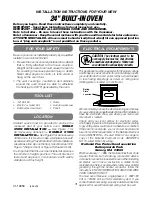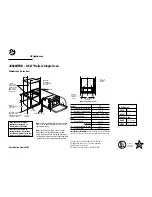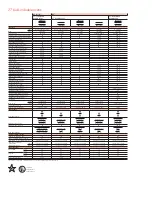
21
Poultry
The weights of the table are for unstuffed birds ready to roast.
Place whole birds on the wire shelf initially with the breast side
down. Turn once after
Z
the estimated time.
Turn pieces of meat such as turkey pieces or turkey breasts
over after half the cooking time has elapsed. Turn the pieces of
poultry after
Z
the time has elapsed.
If cooking duck or goose, prick the skin below the wings to
release the fat.
The birds can be made brown and crunchy if they are smeared
with butter, brine or orange juice more or less at the end of
cooking time.
If grilling directly on the shelf, place the enamel tray on level 1.
Fish
Turn the fish pieces after
Z
the time has elapsed.
Whole fish do not need to be turned over. Bake whole fish in
swimming position with the dorsal fin up. So that the fish
remains stable, place a cut potato or a small container suitable
for baking into the abdomen of the fish.
To cook fish fillets, add a few tablespoons of liquid when
cooking.
If grilling directly on the shelf, place the enamel tray on level 1.
Tips for roasting and grilling
Poultry
Weight
Accessories and
cookware
Level Heating Temperature
at °C, grill power
Time
in minutes
Chicken, whole
1.2 kg
Wire shelf
2
7
220-240
60-70
Poularde, whole
1.6 kg
Wire shelf
2
7
210-230
80-90
Chicken, halves
500 g each
Wire shelf
2
7
220-240
40-50
Chicken pieces
150 g each
Wire shelf
3
7
210-230
30-40
Chicken pieces
300 g each
Wire shelf
3
7
210-230
35-45
Chicken breasts
200 g each
Wire shelf
3
(
3
30-40
Duck, whole
2.0 kg
Wire shelf
2
7
190-210
100-110
Duck breasts
300 g each
Wire shelf
3
7
240-260
30-40
Goose, whole
3.5
4.0 kg
Wire shelf
2
7
170-190
120-140
Goose legs
400 g each
Wire shelf
3
7
220-240
40-50
Small turkey, whole
3.0 kg
Wire shelf
2
7
180-200
80-100
Turkey roll
1.5 kg
uncovered
1
7
200-220
110-130
Turkey breast
1.0 kg
covered
2
%
180-200
90
Turkey thigh
1.0 kg
Wire shelf
2
7
180-200
90-100
Fish
Weight
Accessories and
cookware
Level Heating Temperature at °C,
grill power
Time
in minutes
Fish, whole
of approx. 300 g
Wire shelf
2
(
2
20-25
1.0 kg
Wire shelf
2
7
200-220
45-55
1.5 kg
Wire shelf
2
7
190-210
60-70
2.0 kg
covered
2
%
190-210
70-80
Ventresca fish, 3 cm thick
Wire shelf
3
(
2
20-25
Fish fillet
covered
2
%
210-230
25-30
The table does not contain information
for the weight of the joint.
Select the next lowest weight from the instructions and extend the time.
How to tell when the roast is ready.
Use a meat thermometer (available from specialist shops) or carry out a “spoon test”.
Press down on the roast with a spoon. If it feels firm, it is ready. If the spoon can be
pressed in, it needs to be cooked for a little longer.
The roast is too dark and the crackling
is partly burnt.
Check the shelf height and temperature.
The roast looks good but the juices are
burnt.
Next time, use a smaller roasting dish or add more liquid.
The roast looks good but the juices are
too clear and watery.
Next time, use a larger roasting dish and use less liquid.
Steam rises from the roast when basted. This is normal and due to the laws of physics. The majority of the steam escapes through
the steam outlet. It may settle and form condensation on the cooler switch panel or on
the fronts of adjacent units.








































